Title – Urban and Regional Planning Development Strategies for Pune Metropolitan Region
Abstract: The research paper aims to answer the research question: what are the Urban and Regional development strategies for the Pune metropolitan region? Chapter 1 is the basic introduction of the region and how both, the region the city is diverse in its own kind. Chapter 2 gives a brief economic strategy at regional and city level including the opportunities for the tourism industry. Chapter 3 explores through the strategies for affordable housing and redevelopment of the slum settlements. Chapter 4 discusses environmental strategies both for the region and the city, stating the aims and objectives of the strategies, followed by the contents of the strategy itself. Chapter 5 is about disaster management commenting on different kind of disaster management strategies for regional and at city level planning. Finally, the paper is being concluded and is summarised for the planning policy making.
- Introduction
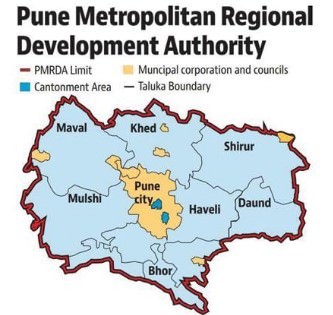
Located in the western margin of the Deccan plateau Pune Metropolitan Region is approximately 50 Kms on the leeward side of the Sahyadri or the Western Ghats. The plateau falls in Deccan Trap Basalts of Cretaceous-Eocene age with the west coast and the Kokan plane is located at 100 kms on the western side of the region. Many rivers in the region like Bhima, Mula, Pawana, Ram and Dev flow through the crevices into the basalt or sometimes into late Quaternary alluvium, which occurs in patches. The region has huge impetus for growth of new businesses & expansion of existing ones due to its proximity to India’s financial capital – Mumbai and is gifted with salubrious climate, abundance of natural resources and rich cultural heritage. The development of the industries along Pimpri-Chinchwad industrial belt has given jobs to many.
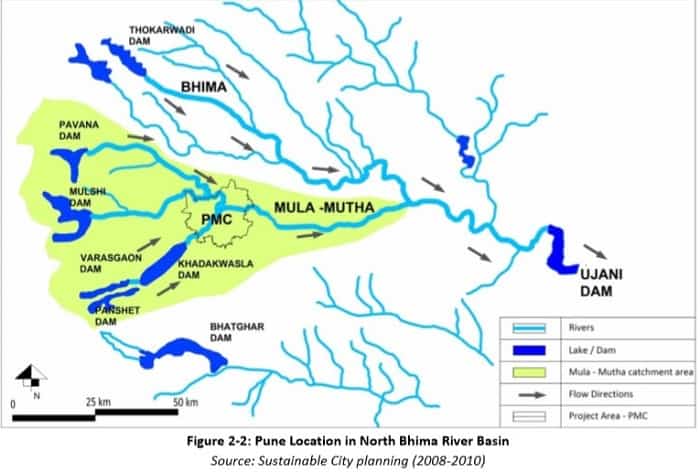
As far as Pune city is concerned it is surrounded by hills on the east and the south forming a souses shape terrain with beautiful mountain views on the periphery. To name few, Sinhagad-Katraj drive ghat range are on the southern boundary of the urban area, Vetal hill (800m) being the highest point in the city and Sinhagad fort (1400 m) being the highest point in the region on the fringes. Pune is diverse in its natural beautiful landscape surroundings and is historically, culturally rich, and has a strong socio-economic fabric which is narrated throughout the city. The core city area is full of well-preserved heritage buildings, traditional suburban style neighbourhoods and efforts are also made by the corporation to develop parks, gardens, roads and transport system within the city.
Pune Metropolitan Region has an area of 7,256.46 Sq. Km and a population of approximately 7.3 million. It attracts several manufacturing industries and is being recognised as a hub for information technology in the recent decade or two. The city is famous for its educational institutes such as Fergusson College, Bhandarkar Institute, Gokhale Institute, Ranade Institute and is phrased as ‘The Oxford of the East’. Due to presence of these educational institutes, industries and branches of virtually every array flourish here making city’s development comprehensive and prosperous. Furthermore, it has become centre for administration and the bustling economy and is cultural capital of Maharashtra state with renowned places and tourist attractions.
2. Economic strategies
2.1 Regional level economic strategies:
For any region socio-economic strategies are the most important strategies to be dealt with. The economy of the region depends on various factors such as its geography, agriculture, transport routes, tourism, urban economic centres, employment pattern, local culture, and the modern trends. Pune metropolitan region is a very diverse region with excellent weather conditions attracting huge amount of private and public sector investment. The eastern part of the region like Khed, Shirur, Daund, and Purandar, Baramati, Indapur is rich with several feet deep layers of black cotton soil which is suitable for Rabi crops such as wheat, gram, jowar, and sugarcane, as it retains moisture for long time. The areas of Junnar, Ambegaon, and khed has red soil which is suitable for bajara, groundnut and chilies. Lastly, paddy fields are grown in Maval, Mulshi, Velhe and western parts of Khed, Ambegaon and Junnar. Almost 77% of the area is under cultivation and 23% area is under irrigation. Planning for more area under irrigation with the help of simple techniques like bunding is required at places to increase the water table level which will result in increase in commercial crop yield.
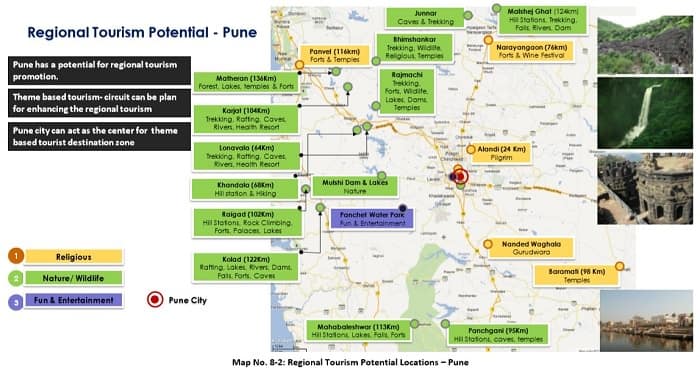
Pune metropolitan region is the 3rd highest region in Maharashtra for domestic tourist visiting the area and 2nd highest region in Maharashtra for international tourist visiting area. The Pune Metropolitan region has a number of tourist destinations as it was once a bastion of Shivaji Maharaja in the 17th century and has many forts and temples in the region. Development of these tourist destinations is a clear strategy for the revenue generation and creating a brand that would help in conserving these areas if put to use. It is also necessary to develop the infrastructure surrounding the region including transport facilities and roads to have a comprehensive strategic planning for the region.
2.2 Urban level economic strategies:
In the city area there are many educational institutes which adds to the influx of the city population and its economy. Many companies prefer to invest in Pune because of the available infrastructure in education and it’s young and intelligent human resource. In the last two to three decades IT industry has grown to its maximums potential creating substantial amount of jobs both in formal and informal sector. The inclusion of 23 villages within PMC limit has made it possible to accommodate the newly migrated citizens to settle and establish themselves in the city. However, due to increase in the population and the expansion of the city limits there is a tremendous pressure on cities infrastructure. As a result, the city has become crowded and urban issues such as urban sprawl, overcrowding, insufficient infrastructure, limited utility services, ineffective policy design has led to decay and destruction of the city. A comprehensive strategic planning of available resources with focus on research-based demand and supply is required taking into consideration the urban design standards and growth strategy. New urban centres should be encouraging for the development with research and studies involving economic and environmental impact assessment.
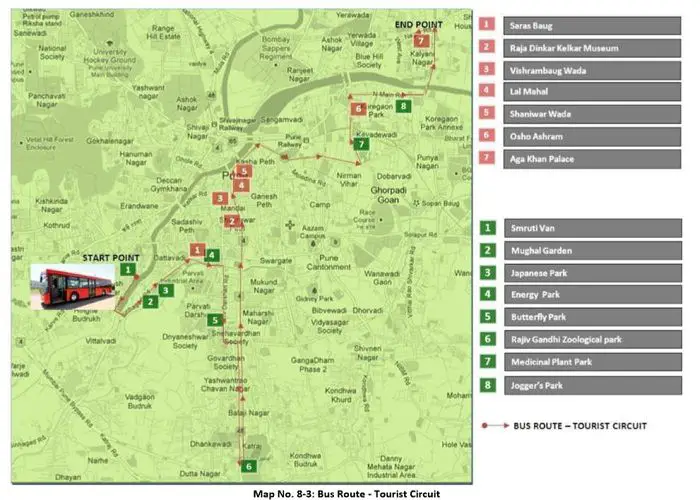
Pune city is well known for its historical monuments and palaces of Maratha, Peshwa and the British era clearly projecting a different architectural character of the town with modern buildings making its way through the traditional buildings. The dense city core is full of traditional housing, locally known as ‘Wada’ displaying the heritage of the city and the colonial part with palatial Indo- Saracenic style bungalows. Other than this ancient architectural heritage fabulous museums have added value to the culture and heritage of the town. The small – town landscape of yesteryears has become a sophisticated metropolitan stretch marked by swanky residential towers, integrated townships, chic malls, glass and chrome offices, and sprawling infotech parks. Private hospitals and medical facilities in the city have improved health for many and it has become a destination for those who want to be treated for the lifesaving diseases.
The reason to protect this heritage is to build an image of the city and improve on its cultural heritage by converting the old buildings into museums or hotels generating the revenue for the city and putting these monuments in use. Such strategies make the overall development of the city and generate employment for the locals adding not only to the economy of the city but also adds to the social welfare. Thus, the development is much more balanced in all the aspects of the citizen’s life. Protection of social institutions and its enhancement will provide better choices for the people to fulfil their aspirations in life. More and more people would be interested living in the city not only for the economic reasons but what the city has to offer in terms of social values.
3. Strategies for affordable housing and slums
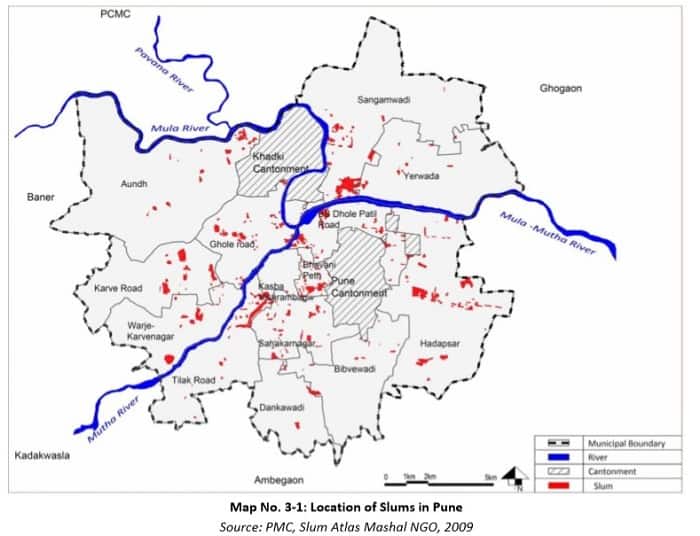
The high level of employability in the city attracts number of jobs in the informal sector which are fulfilled by migrants coming from rural areas not only from the state but from the nation as a whole, forming the economically weaker section of the society. These groups are not provided with proper housing by their employers and are forced to live in shanty settlements known as slums. The map (Fig.5) shows the spread of the slums in the city area spread across its length and breadth. There are about 40% people who live in slums as per the 2001 data from City Sanitation Plan in Pune, and it is inevitable that it will grow to almost 50% in coming years due to growth trends in Pune.
3.1 Legal strategies for slum rehabilitation:
Government of Maharashtra announced the Slum Rehabilitation Scheme (SRS) on 1st January 1995 where rehabilitation of the slum dwellers in done in situ. Slum Rehabilitation Schemes are adopted on a land where reservations of the land use map are applied. Tenement density of 500 Dwelling Unit/Ha with 2.5 floor space index (FSI) is considered for such schemes and an area of 25 sqm. is provided free of cost to the slum dwellers. However, there is no provision for transferable development rights (TDR). These provisions are made to develop housing stock and improve the infrastructure such as sanitation, water supply and waste disposal at a faster pace. These schemes are under way in Pune municipal corporation (PMC) and Pimpri Chinchwad Municipal Corporation (PCMC) and Maharashtra Industrial Development Corporation (MIDC) areas and a total of 23 schemes have been sanctioned till 2009. Construction work has been completed in 17 SRS schemes with 887 tenements covering an area of 35,695.11 Sq.m. Six SRS schemes are in progress, which will add another 1610 tenements covering an area of 65,217.54 Sq.m.
3.2 Strategies for slum prevention
The current trend in housing supply suggests that there is excess supply in HIG and MIG schemes and shortage of supply in affordable housing sector. Such an imbalance in the supply is resulting in the scarcity of land and development of new slum areas in the pockets of land parcels. Thus, the aim of this strategy is to prevent new slums from coming up within the city. For this, a new legislation needs to be passed to provide minimum affordable housing stock in private sector HIG and MIG schemes. Thus, if the people from EWS and LIG sections of the society are provided with affordable housing options, there will be no new slums coming up. The poorest of the poorest should get the first preference for upgrading and non-tenable sites must be identified for the relocation.
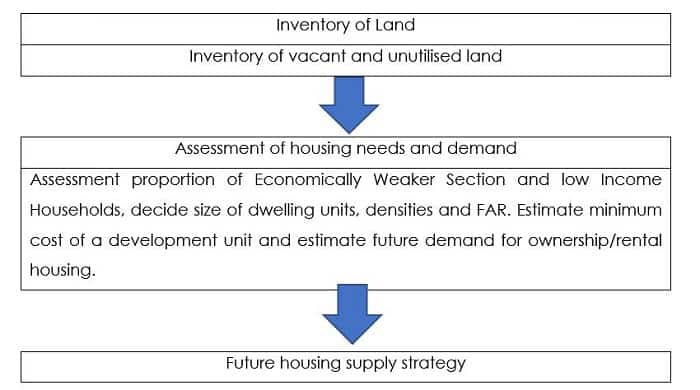
3.3 Demand assessment for affordable housing
As the side effect of urban growth and demand for employment in the tertiary sector has increased, leading to increase in the demand for new affordable housing. The employers don’t provide housing for these people and there is a burden of this local infrastructure is on the local authorities. Other factors that attract the migrant population are economic growth, employment opportunities and rise in land and property market. Thus, the affordable housing demand assessment is done on the above-mentioned parameters. Then the projects in situ and the projects which require relocation, both are identified. Plans are prepared with bare minimum requirements into consideration for affordable housing and the supply side is made strong.
4. Environmental strategies
4.1 Aim of the environmental strategies:
The aim of the environmental strategies is to preserve natural resources such as water and energy. To develop quality placemaking around the residential areas such as open spaces, green areas and a variety of quality leisure areas for the residents. Finally, at regional level, to retain, preserve, restore and develop region’s natural resources such as rivers, hills, vegetation air and water quality.
4.2 Strategies & Priority Action for the environment:
- Protection of green areas: Tree plantation and preservation should be done in order to improve aesthetic looks and to reduce air and noise pollution. The planning strategies should include regular monitoring of compensatory tree plantation, development of new parks and open spaces, preserving urban green corridors and develop proper linkage enhancing the local climate and urban wildlife. Finally, protection of endangered species within the region.
- Protection of Bio-Diversity: Planning strategies for development and implementation of Biodiversity Management Plan. Special provisions and Implementation strategies for Special projects like Biodiversity Park at Baner/ Pashan lake, Pashan Panchwati, Sutarwadi, Hadpsar, Mohammadwadi, Kondhwa Budruk. Finally, preserving natural water resources and develop a master plan for rainwater harvesting.
- Improving Air Quality: Planning strategies for improving air and water quality include Regular vehicular checks like Pollution Under Control (PUC), keeping air pollution levels within prescribed levels. In addition, continuous monitoring at various locations within the city at regular intervals. Also, Promoting the use of alternate fuels like CNG and the reduction, reuse and recycling of waste.
- Provision of Utility Services: Provision of suitable site for the construction and demolition waste should be made available for an appropriate disposal. Similarly, at neighbourhood level provision for preliminary sorting, aggregation of dry recyclables and composting should be made available. Systematic segregation of waste and well-designed landfill sites should have arrangements for leachate collection, prevention of fire hazards and improved air quality. Other than these services, water supply pumping should be made using energy efficient technologies. Water supply sources in north and north – east area of the city need to have alternative options. Along with implementation of eco-housing concepts in delivery of housing projects, monitoring of water quality in the river and sewage coverage network in slum area should be prioritised.
- Recommendations: Technological improvements such as public transport system, solar street lights and policies which include implementation of building codes, recycling requirements. Promotion of voluntary actions, including awareness campaigns and recognition programs to be conducted at city level. Finally, after implementation, monitoring of Environmental Management Plan (EMPs) for various proposed projects in Pune City.
5. Disaster Management:
5.1 Aims of Disaster Management Strategies:
Proactive and reactive integrated disaster management for all communities in the Pune City Municipality, so that the consequences of disasters can be eliminated or reduced through a safe and sustainable environment.
5.2 Planning Strategies:
- Seismicity/ Earthquake: Independent private agencies to perform a survey to identify structures which require treatment, retrofitting or need to be demolished and re-built. Other than demolishing unauthorized structures, there should be an awareness programmes conducted for the citizens, regarding indication of an earthquake and action needed to be taken in case of an earth quake. Structures like overhead water tank should follow structural safety guidelines and important public places such as Police station, railway station, divisional office buildings, schools and colleges should be equipped with hooters.
- Flood Prone Areas: As a planning strategy riverside must have a buffer of no development zone of 100mt and should be converted to municipal gardens. Plinth level of houses to be kept above the highest flood level ever recorded in the last 30 years. To prevent flooding, entire stretch of the river should be embanked above the highest flood level.
- Landslide Prone Areas: Hill slopes and hill tops along the road should be planted with suitable shrubs and trees to ensure enhancement of soil holding capacity. Dangerously located slum areas to be relocated away from the landslide prone areas.
- Fire Hazards: There is a requirement of 23 fire brigade centres which are required within the extended Pune Municipal Corporation (PMC) limit. PMC needs to provide land for accommodating these fire stations. Apart from this physical infrastructure the authorities need to invest in Human resource development and Public education and awareness. For this, training institute, fully equipped Control room GIS, GPS, Computerization etc.
- Biological Hazards: The source of biological hazards is generally from unauthorised vendors of food products. Therefore, checking at community kitchens, restaurants and hotels should be done. Proper waste disposal from these public places should be ensured for safety. Other than this, river channels should be cleaned and sewage flow in the river basin should be terminated. In places like slums cleaning, fumigation and disinfectant sprays should be carried out.
- Anti-terrorism: Installation of CCTV cameras in public spaces such as bus stands, railway stations and public offices as well as cinema theatres and Malls.
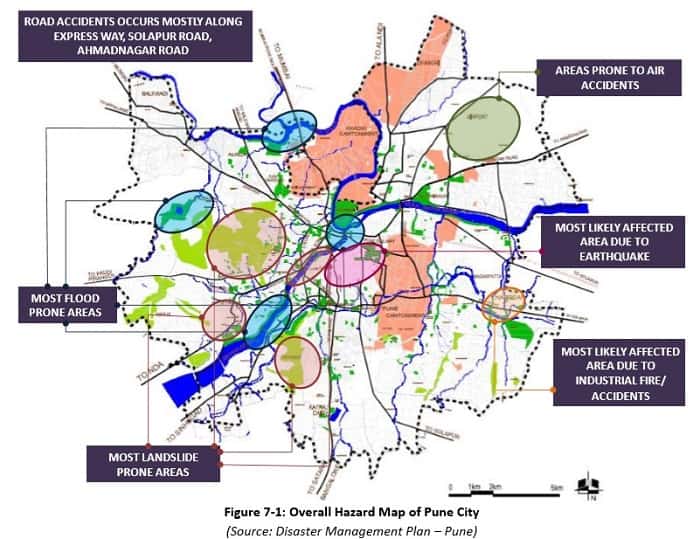
6. Conclusion:
In conclusion, Urban and Regional Planning Development strategies for Pune Metropolitan Region need to be comprehensive in nature. Implementation of these strategies should come under strong government legislations and be part of annual plans at local level and five-year plans at national and state level. Appropriate human resource and governance should make these strategies workable at regional and city level. Economic strategies discussed here should make the implementation run on autopilot mode and the revenue generated should be used for infrastructure, slum rehabilitation, environment and disaster management development in the region and at city level.
References:
- Kuklinski, A. (Ed.). (1977). Social issues in regional policy and planning. Retrieved from https://login.library.britishcouncil.org.in:4443/login?qurl=https://ebookcentral.proquest.com%2f
- McCarthy, J. (2016). Partnership, collaborative planning and urban regeneration. Retrieved from https://login.library.britishcouncil.org.in:4443/login?qurl=https://ebookcentral.proquest.com%2f
- Gillie, F. B. (2015). Basic thinking in regional planning. Retrieved from https://login.library.britishcouncil.org.in:4443/login?qurl=https://ebookcentral.proquest.com%2f
- Bhat, L. (1970). Regional Planning in India. Sankhyā: The Indian Journal of Statistics, Series B (1960-2002), 32(3/4), 391-546. Retrieved February 21, 2020, from www.jstor.org/stable/25051736
- Jacobson, L., & Prakash, T. (1968). URBANIZATION AND REGIONAL PLANNING IN INDIA. Ekistics, 25(148), 158-165. Retrieved February 21, 2020, from www.jstor.org/stable/43621647